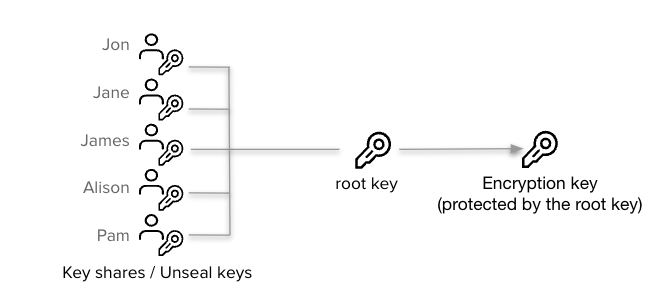Vault
Architecture
Vault is an intricate system with numerous distinct components. This page details the system architecture and hopes to assist Vault users and developers to build a mental model while understanding the theory of operation.
Note: This page covers the technical details of Vault. The descriptions and elements contained within are for users that wish to learn about Vault without having to reference the source code. Although not required, we encourage all users and operators to review the provided information before using Vault due to its significance in an environment.
High-Level overview
The diagram below illustrates the intricacies and distinct components of Vault.
Vault’s encryption layer, referred to as the barrier, is responsible for encrypting and decrypting Vault data. When the Vault server starts, it writes data to its storage backend. Since the storage backend resides outside the barrier, it’s considered untrusted so Vault will encrypt the data before it sends them to the storage backend. This mechanism ensures that if a malicious attacker attempts to gain access to the storage backend, the data cannot be compromised since it remains encrypted, until Vault decrypts the data. The storage backend provides a durable data persistent layer where data is secured and available across server restarts.
When a Vault server is started, it begins in a sealed state. Before any operation can be performed on Vault, it must be unsealed. This is done by providing the unseal keys. During the Vault initialization, it generates an encryption key, which is used to protect all Vault data. This key is protected by a root key that is stored alongside all other Vault data, but is encrypted by another mechanism: the unseal key.
By default, Vault uses Shamir's Secret Sharing to split the unseal key into a configured number of shards (key shares or unseal keys). A precise number of shards are required to reconstruct the unseal key, which is then used to decrypt the Vault's root key.

Refer to the Seal/Unseal documentation for further details.
The number of shares and the minimum number of shards required can both be specified. Shamir's technique can be disabled, and the root key can be used directly for unsealing. Once Vault retrieves the encryption key, it decrypts the data in the storage backend, and enters the unsealed state. Once unsealed, Vault loads the configured audit devices, auth methods, and secrets engines.
Note: The default Vault configuration uses a Shamir seal; however, Vault can be auto unsealed by a trusted cloud key management system (KMS) or hardware security module (HSM) to increase security.
The configuration of the audit devices, auth methods, and secrets engines are security sensitive and are stored in Vault. Users with permissions can modify them and cannot be specified outside of the barrier. By storing them in Vault, changes are protected by the ACL system and tracked by audit logs.
Requests may be processed from the HTTP API to the core once Vault is unsealed. The core manages the flow of requests through the system, enforces ACLs, and ensures audit logging is done.
When a client first connects to Vault, the client needs to authenticate. Vault provides configurable auth methods and offers flexibility within the authentication mechanism used. Mechanisms such as username/password or GitHub may be used for operators, while applications may use public/private keys or tokens to authenticate. An authentication request that flows through the core and into an auth method determines if the request is valid and returns a list of associated policies.
Policies are just a named ACL rule. For example, the "root" policy is built-in
and permits access to all resources. You may create any number of named policies
with fine-grained control over paths. Vault operates in an allowed-access mode, meaning the action is not allowed unless access is granted via a policy explicitly. Since a user may have multiple policies associated, actions are allowed when policy permits. Policies are stored and managed by an internal
policy store. This internal store is affected through the system backend,
which is always mounted at sys/.
Once authentication takes place and an auth method provides a set of applicable policies, a new client token is generated and managed by the token store. This client token is used to make future requests. This token method is similar to a cookie sent by a website when a user logs in. Depending on the auth method configuration, the client token may have a lease associated with it, and may need to be renewed periodically to avoid invalidation.
Once authenticated, requests are made by providing the client token. The client token is used to verify the client, ensuring they are authorized while loading the relevant policies. The policies are used to authorize the client request. The request is then routed to the secrets engine, which is processed depending on its type. When the secrets engine returns the secret, the core registers it with the expiration manager and attaches a lease ID. Clients use the lease ID to renew or revoke their secret. The expiration manager automatically revokes the secret if a client allows the lease to expire.
The core logs requests and responses to the audit broker, distributing the requests to all configured audit devices. Outside of the request flow, the core performs specific background activities. Lease management is critical, allowing expired client tokens or secrets to be revoked automatically. Additionally, Vault handles specific partial-failure cases by using write-ahead logging with a rollback manager. This is managed transparently within the core and is not user-visible.
Resources
- To learn more about each components and sub-systems within Vault, select a topic from the left-navigation menu.
- For in depth details, consult the code.
- To get started with Vault, try out our Getting Started tutorial.
